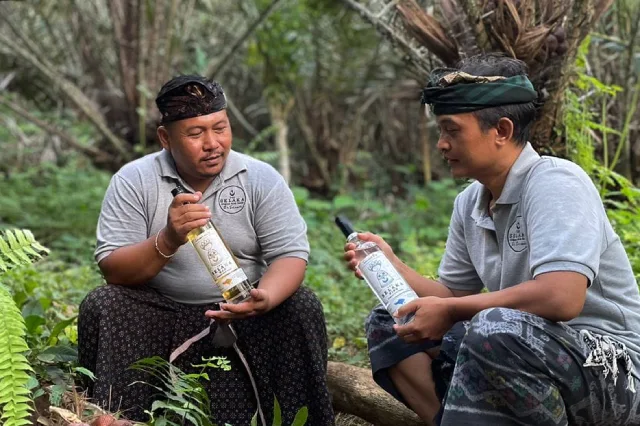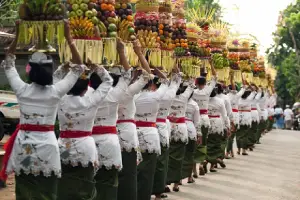Things to Do in Bali
Balinese Textiles – Where Culture is Woven by Hand
Balinese Textiles – Where Culture is Woven by Hand
In Bali, textiles are more than just cloth. They are worn by gods, wrapped around temples, carried in processions, and passed down through generations.
From everyday sarongs to sacred offerings, textiles are a living part of Balinese identity. They speak of ancestry, belief, community, and beauty. Every pattern, color, and thread has meaning — rooted in ritual, caste, region, and symbolism.
Bali’s textile heritage is one of the richest in Southeast Asia. Whether it’s the shimmering gold of a royal songket, the earthy reds of a protective geringsing, or the iconic black-and-white poleng seen wrapped around sacred trees — these fabrics carry stories that words alone cannot tell.
Textiles in Bali are used in nearly every ceremony, from birth to cremation. They are also a marker of daily life: worn to the market, the rice fields, or temple festivals. The act of dressing — layer by layer — is itself a ritual.
This guide explores the world of traditional Balinese textiles: their types, meaning, ceremonial use, regional origins, and the women who continue to weave them by hand. It’s a journey into one of the island’s most profound and beautiful traditions.
Let’s start with the different types of traditional textiles you’ll encounter across Bali.
Did You Know? – Sacred Textile Facts
Balinese textiles are full of mystery, symbolism, and ancestral wisdom. Here are some fascinating facts about the sacred role of cloth in Bali:
- Geringsing cloth can take up to five years to complete — the most complex textile process in Bali.
- Only three places in the world produce true double ikat: Tenganan (Bali), Patan (India), and Okinawa (Japan).
- Poleng cloth (black-and-white checks) symbolizes the duality of the cosmos — good vs. evil, light vs. dark, sacred vs. worldly.
- Sacred cloths must never touch the ground. They are treated with the same reverence as temple offerings.
- Temple statues are dressed in textiles during ceremonies — a way of “awakening” them and inviting the deity to be present.
- Some sacred weaving processes require fasting and ritual purity before the work can begin.
- Bebali cloths are never worn casually — they’re reserved exclusively for altars, shrines, and spiritual offerings.
- Each color has meaning: white (purity), red (energy), black (protection), yellow (sacredness), often aligned with directions and deities.
- In some Balinese villages, a girl’s ability to weave is still seen as a sign of spiritual and social maturity.
Types of Traditional Balinese Textiles
Bali’s textile traditions are incredibly diverse, each with its own function, symbolism, and origin. Below are some of the most important cloth types you’ll encounter across the island — in rituals, ceremonies, and daily life.
Songket
Songket is a luxurious handwoven textile embellished with shimmering threads of gold or silver. Traditionally worn during royal ceremonies and weddings, it reflects status, elegance, and spiritual richness. Bali’s finest songket is often made in Klungkung, Karangasem, and Sidemen.
Endek
Endek is Bali’s everyday ikat — a soft, patterned cloth made using a single ikat technique (dyed only in the weft). Once reserved for temple offerings and nobility, it’s now commonly used for sarongs, shirts, and uniforms. It combines tradition with practical wearability.
Cepuk
Originating from Nusa Penida and parts of Karangasem, cepuk textiles are bold and geometric, often used as ceremonial cloths for protection. Woven in red and white tones, they’re considered spiritually powerful and are draped over altars and used during rites of passage.
Geringsing
Geringsing is Bali’s rare and sacred double ikat textile, made exclusively in the village of Tenganan. With both warp and weft threads dyed before weaving, the process is highly complex. These cloths are believed to have healing and protective powers.
Poleng
This black-and-white checkered cloth is found wrapped around sacred trees, statues, and shrines. It symbolizes the balance of opposites — good and evil, light and dark — and serves as a constant reminder of harmony in Balinese Hindu belief.
Perada
Perada is a decorative cloth painted or printed with gold leaf, often used to embellish ceremonial umbrellas, temple decor, or dance costumes. While less intricate than woven songket, it adds radiance and is widely used in religious settings.
Bebali Cloth
Used exclusively for temple rituals and offerings, bebali cloths are considered sacred. These textiles are never worn casually and are often reserved for wrapping deities, lining shrines, or covering ceremonial objects. Their patterns and colors follow strict symbolic codes.
The Role of Textiles in Ceremonial Life
In Bali, textiles are more than aesthetic objects — they are sacred instruments used to honor the gods, protect the body, and maintain spiritual balance. Nearly every religious or life-cycle ceremony involves cloth in some form. It is wrapped, layered, tied, offered, or displayed — always with intention.
Textiles are part of the ritual language of Bali. They communicate respect, purity, social status, and cosmological symbolism. The way a cloth is worn, its color, pattern, and placement — all carry meaning in a ceremonial context.
Temple Ceremonies & Rituals
During temple festivals, textiles are used to dress statues, wrap shrines, decorate bamboo structures, and line offering platforms. Bebali cloths, considered sacred, are reserved exclusively for these purposes and never worn casually.
Tooth-Filing (Metatah) & Weddings
In rites of passage like metatah (the tooth-filing ceremony symbolizing the transition into adulthood), specific cloths are worn by the initiate to signify purity and spiritual readiness. Brides and grooms wear elaborate songket during traditional weddings, not just for beauty, but as a marker of lineage and community pride.
Funerals & Cremation (Ngaben)
Textiles play a central role in death rituals. The deceased is often wrapped in white cloths for purification, and additional layers of endek or patterned cloths are used to guide the soul to the next realm. Cloths may also line the funeral tower or cremation platform.
Color, Direction & the Cosmos
Balinese Hinduism associates colors and cloth patterns with the cardinal directions, deities, and cosmic forces:
- White (Pura) – East – Iswara (Purity)
- Red – South – Brahma (Creation)
- Black – North – Vishnu (Preservation)
- Yellow – West – Mahadeva (Dissolution)
- Poleng cloth (black & white checks) symbolizes the duality and balance of opposing forces — good and evil, sacred and profane.
Wearing Textiles as Ceremony
The act of dressing oneself for a temple visit is also a form of ritual. Balinese ceremonial dress includes multiple layers — each with purpose and order. The sash (selendang), sarong (kamben), and shoulder cloth (saput) together prepare the body for sacred space, aligning it with spiritual etiquette.
In Bali, cloth is not just decoration — it is devotion woven into form.
Types of Traditional Balinese Textiles
Bali’s textile traditions are incredibly diverse, each with its own function, symbolism, and origin. Below are some of the most important cloth types you’ll encounter across the island — in rituals, ceremonies, and daily life.
Songket
Songket is a luxurious handwoven textile embellished with shimmering threads of gold or silver. Traditionally worn during royal ceremonies and weddings, it reflects status, elegance, and spiritual richness. Bali’s finest songket is often made in Klungkung, Karangasem, and Sidemen.
Endek
Endek is Bali’s everyday ikat — a soft, patterned cloth made using a single ikat technique (dyed only in the weft). Once reserved for temple offerings and nobility, it’s now commonly used for sarongs, shirts, and uniforms. It combines tradition with practical wearability.
Cepuk
Originating from Nusa Penida and parts of Karangasem, cepuk textiles are bold and geometric, often used as ceremonial cloths for protection. Woven in red and white tones, they’re considered spiritually powerful and are draped over altars and used during rites of passage.
Geringsing
Geringsing is Bali’s rare and sacred double ikat textile, made exclusively in the village of Tenganan. With both warp and weft threads dyed before weaving, the process is highly complex. These cloths are believed to have healing and protective powers.
Poleng
This black-and-white checkered cloth is found wrapped around sacred trees, statues, and shrines. It symbolizes the balance of opposites — good and evil, light and dark — and serves as a constant reminder of harmony in Balinese Hindu belief.
Perada
Perada is a decorative cloth painted or printed with gold leaf, often used to embellish ceremonial umbrellas, temple decor, or dance costumes. While less intricate than woven songket, it adds radiance and is widely used in religious settings.
Bebali Cloth
Used exclusively for temple rituals and offerings, bebali cloths are considered sacred. These textiles are never worn casually and are often reserved for wrapping deities, lining shrines, or covering ceremonial objects. Their patterns and colors follow strict symbolic codes.
Weaving as Heritage
In Bali, weaving is more than a skill — it’s a sacred inheritance passed down through generations of women. Many girls learn to weave from their mothers or grandmothers, beginning with spinning threads and preparing dyes before mastering complex patterns. In some villages, weaving is a social and spiritual duty, closely tied to ritual life and community identity.
The Role of Women
Most traditional Balinese weavers are women. They sit for hours at simple wooden looms, often in open-air workspaces at the back of their homes. Weaving is done not just to earn a living, but to fulfill cultural expectations — preserving cloth traditions that define ceremonial life. In some regions, a woman’s ability to weave is still considered part of her social value and spiritual readiness.
Mythological Origins
According to Balinese lore, the art of weaving was gifted by Dewi Ratih, the Moon Goddess. The loom itself is seen as sacred — its upright post represents the cosmic axis, linking heaven and earth. When a woman weaves, she is said to re-enact cosmic creation, bringing order out of thread and color.
Natural Dyes & Traditional Tools
Many traditional textiles are made using natural dyes sourced from roots, bark, leaves, and minerals. Red from morinda, black from soot or iron-rich mud, yellow from turmeric — these colors are steeped into the threads by hand.
Weavers typically use two types of looms:
- Backstrap looms (also called “cagcag”) — tensioned by the body, used for smaller or sacred textiles like geringsing
- Frame looms — for larger or commercial production, allowing longer weaves and more stability
Sacred vs. Commercial Weaving
There’s an important distinction in Bali between textiles made for ritual use and those made for sale. Sacred cloths follow strict patterns, rituals, and timing — sometimes even requiring fasting or offerings before weaving begins. Commercial cloths, while still crafted with skill, are not bound to these ceremonial rules.
To weave in Bali is to preserve the invisible threads that hold belief, identity, and balance together.
Types of Traditional Balinese Textiles
Bali’s textile traditions are incredibly diverse, each with its own function, symbolism, and origin. Below are some of the most important cloth types you’ll encounter across the island — in rituals, ceremonies, and daily life.
Songket
Songket is a luxurious handwoven textile embellished with shimmering threads of gold or silver. Traditionally worn during royal ceremonies and weddings, it reflects status, elegance, and spiritual richness. Bali’s finest songket is often made in Klungkung, Karangasem, and Sidemen.
Endek
Endek is Bali’s everyday ikat — a soft, patterned cloth made using a single ikat technique (dyed only in the weft). Once reserved for temple offerings and nobility, it’s now commonly used for sarongs, shirts, and uniforms. It combines tradition with practical wearability.
Cepuk
Originating from Nusa Penida and parts of Karangasem, cepuk textiles are bold and geometric, often used as ceremonial cloths for protection. Woven in red and white tones, they’re considered spiritually powerful and are draped over altars and used during rites of passage.
Geringsing
Geringsing is Bali’s rare and sacred double ikat textile, made exclusively in the village of Tenganan. With both warp and weft threads dyed before weaving, the process is highly complex. These cloths are believed to have healing and protective powers.
Poleng
This black-and-white checkered cloth is found wrapped around sacred trees, statues, and shrines. It symbolizes the balance of opposites — good and evil, light and dark — and serves as a constant reminder of harmony in Balinese Hindu belief.
Perada
Perada is a decorative cloth painted or printed with gold leaf, often used to embellish ceremonial umbrellas, temple decor, or dance costumes. While less intricate than woven songket, it adds radiance and is widely used in religious settings.
Bebali Cloth
Used exclusively for temple rituals and offerings, bebali cloths are considered sacred. These textiles are never worn casually and are often reserved for wrapping deities, lining shrines, or covering ceremonial objects. Their patterns and colors follow strict symbolic codes.
Where Bali’s Textiles Come From
Balinese textiles are deeply tied to place. Each region on the island has its own techniques, colors, and sacred patterns — influenced by local belief systems, clan traditions, and historical trade. Below are some of the key centers of textile production in Bali today:
Sidemen (East Bali)
Often called the weaving heart of Bali, Sidemen is famous for its songket and endek. Villages here produce both ceremonial and commercial cloths using traditional looms and natural dyes. Many families have woven for generations, and you’ll find some of the island’s finest artisans here.
Klungkung & Karangasem
These former royal regions are known for refined songket and cepuk production. Klungkung, once home to Bali’s highest court, developed textiles that reflected power and spiritual status. Cepuk cloths woven in this area are often used in temple rituals and healing ceremonies.
Tabanan (Belayu)
This lesser-known region still holds onto rare songket traditions that are slowly disappearing. Some weaving families in Belayu continue to use older patterns and natural materials. Their cloths are often thicker and more geometric, rooted in local ritual life.
Tenganan (Karangasem)
The ancient Bali Aga village of Tenganan is the only place in Indonesia that produces geringsing — a sacred double ikat woven with great precision. The process takes years, and the knowledge is protected within the community. Geringsing cloths are used in life-cycle ceremonies and believed to offer spiritual protection.
Negara / Jembrana (West Bali)
This coastal area is a center for endek and woven sarongs used in daily life and temple visits. Though less known internationally, the weavers here supply large quantities of cloth for both ceremonial and practical purposes across the island.
Types of Traditional Balinese Textiles
Bali’s textile traditions are incredibly diverse, each with its own function, symbolism, and origin. Below are some of the most important cloth types you’ll encounter across the island — in rituals, ceremonies, and daily life.
Songket
Songket is a luxurious handwoven textile embellished with shimmering threads of gold or silver. Traditionally worn during royal ceremonies and weddings, it reflects status, elegance, and spiritual richness. Bali’s finest songket is often made in Klungkung, Karangasem, and Sidemen.
Endek
Endek is Bali’s everyday ikat — a soft, patterned cloth made using a single ikat technique (dyed only in the weft). Once reserved for temple offerings and nobility, it’s now commonly used for sarongs, shirts, and uniforms. It combines tradition with practical wearability.
Cepuk
Originating from Nusa Penida and parts of Karangasem, cepuk textiles are bold and geometric, often used as ceremonial cloths for protection. Woven in red and white tones, they’re considered spiritually powerful and are draped over altars and used during rites of passage.
Geringsing
Geringsing is Bali’s rare and sacred double ikat textile, made exclusively in the village of Tenganan. With both warp and weft threads dyed before weaving, the process is highly complex. These cloths are believed to have healing and protective powers.
Poleng
This black-and-white checkered cloth is found wrapped around sacred trees, statues, and shrines. It symbolizes the balance of opposites — good and evil, light and dark — and serves as a constant reminder of harmony in Balinese Hindu belief.
Perada
Perada is a decorative cloth painted or printed with gold leaf, often used to embellish ceremonial umbrellas, temple decor, or dance costumes. While less intricate than woven songket, it adds radiance and is widely used in religious settings.
Bebali Cloth
Used exclusively for temple rituals and offerings, bebali cloths are considered sacred. These textiles are never worn casually and are often reserved for wrapping deities, lining shrines, or covering ceremonial objects. Their patterns and colors follow strict symbolic codes.
Buying Textiles in Bali – What to Look For
Bali is a wonderful place to buy handwoven textiles — whether for ritual use, home décor, or as wearable art. But not all fabrics are created equal. Understanding the difference between mass-produced tourist items and authentic handcrafted pieces will help you shop more consciously and respectfully.
Handwoven vs. Printed or Factory-Made
Real Balinese textiles are handwoven on traditional looms, often using natural dyes. You can usually spot authentic cloth by its slightly uneven texture, subtle imperfections, and depth of color. In contrast, many cheap “ikat” or “batik” pieces sold in markets are screen-printed or machine-made.
Respect the Culture
Sacred cloths like bebali and poleng carry spiritual meaning. Avoid sitting on them, wearing them in casual settings, or treating them as costume props. If you’re unsure whether a textile is sacred, ask — and when in doubt, treat all Balinese textiles with respect.
Support Local Weavers & Artisan Collectives
Choosing to buy from weaver cooperatives and heritage-focused shops directly supports Balinese families and helps preserve endangered techniques. It also ensures that the people behind the cloth are fairly paid for their artistry.
Where to Buy Authentic Balinese Textiles
- Threads of Life (Ubud) – Museum-quality textiles, ethically sourced from across Indonesia, with deep cultural documentation.
- Sidemen village – Home to many of Bali’s finest songket and endek weavers; buying directly from the source is rewarding and educational.
- Traditional markets – Places like Gianyar Market or Klungkung Market offer a range of cloths, but prices and quality vary. Ask questions and inspect carefully.
Buying a textile in Bali isn’t just shopping — it’s participating in a living tradition. Choose with care, and you take home something far more meaningful than fabric.
Woven into the Soul of Bali
Balinese textiles are more than just beautiful fabrics — they are sacred expressions of culture, memory, and meaning. Every thread carries intention. Every pattern speaks of ancestry. Every color, knot, and motif is a reflection of the island’s complex harmony between the spiritual and the everyday.
To understand Balinese cloth is to understand Bali itself: a place where art is devotion, where the visible world is always in dialogue with the unseen, and where even the act of weaving is a form of prayer.
By learning about these traditions, supporting the weavers, and respecting the rituals tied to cloth, we don’t just preserve an art form — we help protect a way of life.
When you wrap yourself in a Balinese textile, you are wearing a story. One that is still being written, thread by thread.























